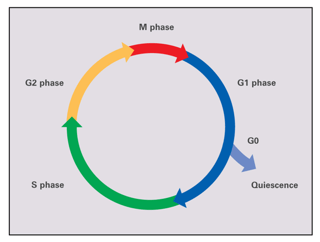If you are currently studying biology, you have probably learned that mistakes in DNA can create very big problems, including cancer. These DNA errors often (but not always) occur during replication. Whenever they occur, it is very important for the cell to have a set of systems in place to both prevent and repair these errors. In this blog post, we will cover some of the common prevention and repair mechanisms built into the cell cycle that might appear in an intro biology course.

Preventing DNA damage
DNA damage is prevented in part by checkpoints in the cell cycle. Each checkpoint plays a unique and important role in ensuring that DNA is free from mistakes and that any cells with DNA mistakes are prevented from dividing. If a checkpoint is not passed, the cell cannot move beyond it to complete the rest of the cell cycle. Here is a brief review of some important checkpoints:
Checkpoint
- The checkpoint is passed if internal and external conditions indicate that it is a good time for division.
- Specifically, the checkpoint is passed if cell size is adequate, nutrients are sufficient, social signals are present, and the cell’s DNA is undamaged.
- This checkpoint is especially important because this is where the cell decides whether or not to divide. If a cell makes it past this checkpoint it will undergo division. If a cell does not make it past this checkpoint, it might leave the cell cycle to enter the checkpoint.
- The checkpoint is passed if the DNA is replicated and undamaged. You can remember this because the checkpoint is when you check your 2 sets of DNA.
- More specifically, the G2 checkpoint is passed if chromosomes have been replicated successfully, DNA is undamaged and certain chemicals that promote entrance into mitosis are present. If this is not the case, the DNA will undergo repair before it moves on in the cell cycle or the cell will self-destruct (undergo apoptosis).
M-Phase Checkpoint
- The M-phase checkpoint is passed if the cell is correctly set up for cell division.
- Specifically, this checkpoint is passed if chromosomes are lined up on the metaphase plate and have attached properly to the spindle apparatus. Note that DNA is not checked at the M-Phase checkpoint, however it is still an important checkpoint for preventing DNA mistakes in cell division.
Repairing mistakes and damage in DNA
What if a mistake occurs in spite of these checkpoints? Well, there are a few other tools that cells have to correct DNA mistakes during the cell cycle. See below for a brief review of two concepts that often appear in intro biology courses.
DNA Polymerase Proofreading
- This process fixes mistakes made during DNA replication. During replication in S phase, DNA polymerase can sometimes add an incorrect nucleotide as it duplicates the DNA.
- DNA polymerase can actually detect this error and remove the incorrect nucleotide. This is called DNA polymerase proofreading
- DNA polymerase proofreading occurs when DNA polymerase uses its exonuclease active site to remove the most recently added nucleotide and then replaces it with the correct nucleotide.
- Note that DNA polymerase can only correct the previously added nucleotide, but not any nucleotides prior to that.
Mismatch repair
- If an error is not corrected by DNA polymerase proofreading it can still be caught by mismatch repair.
- Mismatch repair begins when an enzyme complex scans the DNA. One component of the complex recognizes distortion caused by mismatched base pairing (for example if A was incorrectly paired with C in the duplicated DNA).
- Another component of the enzyme complex acts like a pair of scissors and snips the DNA near the mistake and removes the area surrounding the mistake.
- Next, a DNA polymerase returns to fill in the now empty area with new nucleotides.
- Lastly, DNA ligase repairs the gap in the DNA backbone.
Happy studying!!
Comments